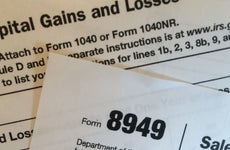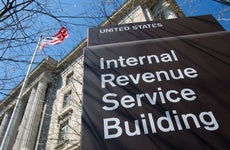Tax credit claims could limit Free File
The Bankrate promise
At Bankrate we strive to help you make smarter financial decisions. While we adhere to strict , this post may contain references to products from our partners. Here's an explanation for .
Free File is back for its 20th year, now allowing taxpayers with adjusted gross incomes of $57,000 or less, regardless of filing status, to e-file their 1040s at no cost.
Bankrate's 2010 Tax Guide
But some filers who likely will turn to tax software to help them decipher a popular new tax break will find they can’t take that final step and e-file their return and credit claim, for free or for a price.
Taxpayers who are eligible for the homebuyer credit, either $8,000 as a first-time buyer or $6,500 as a move-up home purchaser, can’t use Free File this year even if they meet the income eligibility requirements. It’s not the IRS’s fault. Rather, when the credit was extended and expanded in November, Congress added a verification component to help stop fraudulent credit claims.
This means these home purchasers must submit paper documentation, such as a copy of an excited settlement statement, along with their 2009 returns. The IRS realizes this will frustrate some filers and is working to bring tax verification compliance into the electronic realm. That possibility, however, is still down the road.
“Within three years we will have the ability to take in documents in PDF format, that is you can scan and attach it when e-filing,” said David R. Williams, director of Electronic Tax Administration for the IRS, in announcing this year’s Free File program. “But for now, to make sure we’re paying the homebuyer credit correctly, we’re gong to have to take that information on paper.”
New property purchasers can, however, still use Free File to prepare their tax returns, then print and mail the tax forms and documentation paperwork to the IRS.
- The IRS began accepting Free File returns on Jan. 15.
- To use Free File this year, your 2008 adjusted gross income must be $57,000 or less.
- The income cutoff applies regardless of your filing status.
- 19 tax software companies are part of Free File 2010.
- Free File is for individual, not business, taxpayers. However, if you are a sole proprietor and file a Schedule C with your Form 1040, you can use Free File.
- Three companies offer Free File products in Spanish.
- You can e-file your return at any time and schedule any payment of taxes due for a later date, up to the April 15 deadline.
- Access to Free File is available only by going to the IRS Web site, IRS.gov, and clicking on the Free File icon.
The Free File software versions are similar to the products that the software companies offer for sale. Most use an interview-based format so you don’t have to know all the intricacies, tax changes, forms and instructions of the filing process. You answer the question and the software does the rest, including correcting basic tax errors.
You can peruse the various company offerings or use the IRS’s online Free File Wizard, which will direct you to participating software manufacturers that meet your filing needs based on how you answer its questions.
2010 tweaks
Over the last two decades, the IRS has resolved most e-filing issues that have cropped up during Free File. Each year, though, the agency makes a few adjustments to the program.
Since most taxpayers also must file state returns, companies that offer this option are providing links to that service this year. This means, says Williams, that taxpayers will be able to complete both federal and state filings at the same time, without charge.
The IRS also has tightened consumer safeguards. “We’ve included a new opt-in feature, which means Free File users must consent to getting additional information by being asked to opt in for any future marketing messages from a software manufacturer,” says Williams. “If you say ‘no,’ that’s the end of it. It gives consumers more control over what’s marketed to them and more control over their tax return information.”
Free File for all
In addition to the traditional Free File program for filers who made less than $57,000 in 2009, the IRS is again offering Free File Fillable Forms for anyone to use, regardless of income. But the process does have some limitations.
Unlike the traditional Free File programs, there is no interview-based filing system, the assistance method that’s typically associated with tax software. While the forms will do the math automatically, you must know what information needs to go on the forms’ various lines.
Once you’ve completed the forms at your computer, you then press e-file and the tax documents will be sent electronically to the IRS at no charge.
However, if you also need to file a state return, you are on your own. Free File Fillable Forms does not include state forms or state e-filing.
Free File’s future
Last year the Free File program experienced a dramatic drop in usage, going from almost 5 million taxpayers clicking through the site in 2008 to around 3 million in 2009.
“We had concerns about the Free File program because of the decline, so we looked more closely at the numbers,” says Williams. “We found that users who dropped out of Free File went on to use other free tax preparation, filing products.”
In fact, says Williams, Free File is benefiting taxpayers who don’t use or are not eligible for the program. “The existence of free file has pushed the tax software industry to offer more free products of their own,” he says. “Companies that have paid products are now using more free programs. So those taxpayers who stopped using Free File are still e-filing, but have moved to free products offered outside the Free File program.”
And that’s not a problem for the IRS. All types of e-filing are good, regardless of which electronic route is used by taxpayers.
The actual processing of returns is quicker and it’s easier for the agency to handle large numbers of returns when they come in electronically. It also costs Uncle Sam 20 cents per return to deal with an e-filed 1040 instead of the $2.50 per each filing that has to be manually processed.
So as long as more people e-file somehow, Uncle Sam will be happy.
Related Articles


Need to report cryptocurrency on your taxes? Here’s how to use Form 8949 to do it

Cryptocurrency taxes: A guide to tax rules for Bitcoin, Ethereum and more
